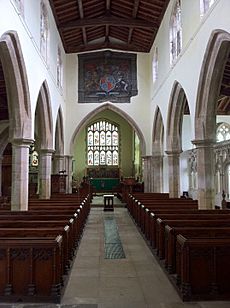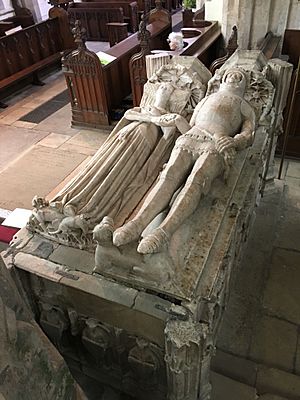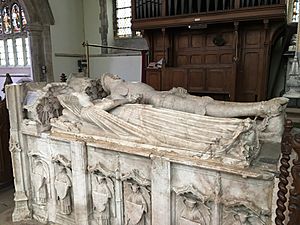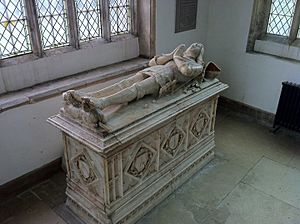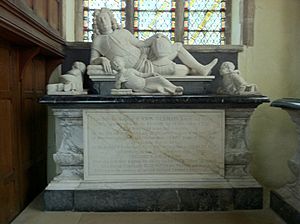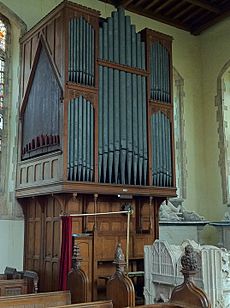St Peter's Church, Lowick facts for kids
Quick facts for kids St. Peter's Church, Lowick |
|
|---|---|

St. Peter's Church, Lowick, Northamptonshire
|
|
| 52°24′42″N 0°33′25″W / 52.41163°N 0.55706°W | |
| Country | England |
| Denomination | Church of England |
| Churchmanship | Broad Church |
| History | |
| Dedication | Saint Peter |
| Architecture | |
| Heritage designation | Grade I listed building |
| Style | Perpendicular Gothic |
| Groundbreaking | circa 1300 |
| Completed | 1460 |
| Specifications | |
| Length | 83 feet (25 m) |
| Width | 40 feet 5 inches (12.3 m) |
| Height | 96 feet (29m) |
| Administration | |
| Parish | Lowick, Northamptonshire |
| Diocese | Peterborough |
| Province | Canterbury |
St. Peter's Church, Lowick is a historic church in Lowick, Northamptonshire, England. It is a Church of England parish church, meaning it serves the local community. This beautiful building has stood for hundreds of years.
Contents
History and Design of the Church
St. Peter's Church was mostly built between the late 1300s and early 1400s. It was constructed for the Greene family, who lived nearby at Drayton House. You can see their family crest, a special shield with symbols, inside the church. One large shield is in the main part of the church, called the nave. Another is in the chancel, which is the area around the altar.
The church tower is very special. It has an eight-sided top, with supports called flying buttresses. There are also 12 tall, pointed decorations called pinnacles. Each pinnacle has a golden weathervane on top. The tower is 96 feet (29 meters) tall. From far away, the weathervanes look like flags fluttering in the wind.
In the 1600s, during a time of change, some parts of the church were updated. For example, in 1644, a special screen called a rood-loft was taken down. In 1645, windows with certain pictures were replaced with plain glass.
The church has been repaired and updated many times over the years. Major restoration work happened between 1868 and 1872. More repairs were done in 1887 and again in the 1970s. A beautiful decorated screen behind the altar, called a reredos, was added in 1930–31. It was made to remember Sackville George Stopford-Sackville.
Stained Glass and Memorials
The church has some amazing old stained glass windows. In the north aisle, there are panels from around 1330–40. They show 16 figures from a "Jesse window," which tells the story of Jesus's family tree. Some medieval glass also remains in the south chancel windows. There are also six windows with beautiful 19th-century stained glass.
Inside the church, you can find many old gravestones and memorials. One gravestone in the chancel floor belongs to John Heton. He was the rector (a type of priest) of Lowick from 1406 to 1415.
Important Family Memorials
- Sir Ralfe Greene: He died in 1417. His memorial is a large stone tomb with two figures carved from alabaster, a soft white stone. These figures represent Sir Ralfe and his wife. Angels are carved around the sides of the tomb. This memorial cost £40, which was a lot of money back then!
- Henry Green: In the south transept (a part of the church that sticks out), there is a tomb for Henry Green, who died in 1467 or 1468. He is shown wearing armor, and his wife has a fancy head-dress.
- Edward Stafford, 2nd Earl of Wiltshire: He died in 1499. His memorial is also an alabaster figure on a stone tomb. He helped rebuild the chapel where his memorial is located.
- Mary Howard, Duchess of Norfolk: She died in 1705. Her memorial is a white marble figure that looks like she is resting. It is in front of the east window.
- Sir John Germain: He died in 1718. His tomb is on the north wall and shows him as a marble figure in armor.
- Lady Elizabeth Germain: She died in 1760. There is a brass tablet in her memory.
- Charles Sackville-Germain, 5th Duke of Dorset: He died in 1843. His memorial is a white marble tomb with a life-sized angel sitting beside it.
Church Bells
The church tower has six bells that can be rung.
- Two bells were made around 1595 by the Watts family, who were famous bell-makers from Leicester.
- Another bell was made around 1599 by an unknown maker.
- The largest bell, called the tenor, was made in 1619.
- The fourth bell was remade in 1884.
- The newest bell was added in 1896, making it a set of six.
The Organ
St. Peter's Church has a pipe organ that was built around 1900 by Wordsworth and Maskell. Before this, the church had a different organ installed in 1861. That older organ was later moved to other churches.
Churchyard
The area around the church, called the churchyard, has many gravestones from the 1700s and 1800s. You can also see a decorative coffin lid from the 1400s near the south chapel wall. At the east end of the churchyard are the graves of the Stopford Sackville family, who have lived at Drayton House for a long time.
List of Rectors
Here is a list of the rectors, or head priests, who have served St. Peter's Church over the centuries:
- Nicholas de Nevil 1217
- Almaric de Nowers 1247
- Radulphus de Nowers 1303
- Radulphus de Drayton 1303–14
- Adam de Waltham 1314–20
- Johannes de Clypston 1320–49
- Johannes de Irthlynburgh 1349–57
- Johannes de Ryngestede 1357–79
- Henry Bolymere 1379–82
- Robert Normanton 1382–94
- Walter de St Germain 1394–1406
- John Heton 1406–15 (buried in the church)
- John Boys 1415–17
- John Glapthorn 1417–22
- John Boys (again) 1422–55
- John Martyn 1455–79
- Henry Smyth 1479–83
- William Peryn 1483–1509
- William Hamswayte 1509–35
- Edmund Mordante 1535–45
- Henry Quyk 1545–66
- Thomas Buckoke 1566–1603
- Robert Lingard 1603–47
- Joseph Bentham 1648–??
- Michael Poulton 1693–1720
- Robert Welborne 1720–44
- Richard Etough 1744–79
- Henry Etough 1779–95
- Thomas Fancourt 1795–97
- Joseph Jackson 1797–1815
- Robert Morgan Vane 1815–42
- John Stoddart 1842–55
- Henry George Middleton Pretyman 1855–70
- Main Swete Alexander Walrond 1870–73
- William Lucas Collins 1873–87
- John Sykes Watson 1887–1906
- Alfred Dicker 1906–25
- Arthur Sidney Hazel 1926–35
- Percival William Worster 1935–52
- Richard Clough 1952–59
- Wilfred Pakenham Pakenham-Walsh 1959–65
- Leslie Ronald Frank Buttle 1965–74
- Harry Bertram Davies 1974–81
- Cheslyn Peter Montague Jones 1981–87
- Michael James Thompson 1987–94
- Ronald Douglas Howe 1994–2000
- Hartley Roger Watson 2000–2008
- Simon John Plumley Fisher 2008-2011
- Colin Fletcher, Priest in charge
- Heather Lowe 2017


